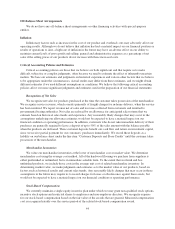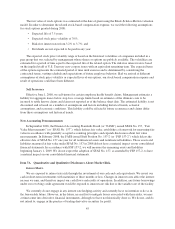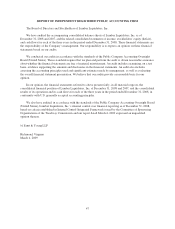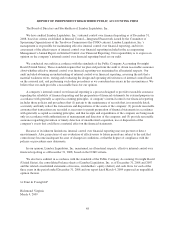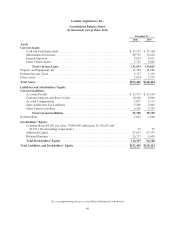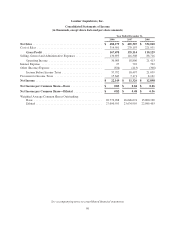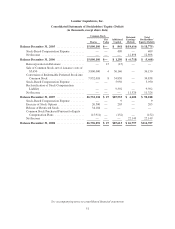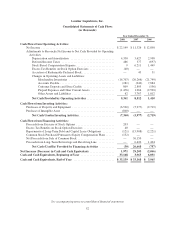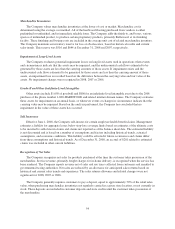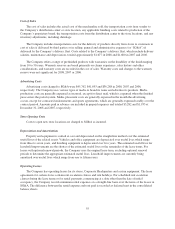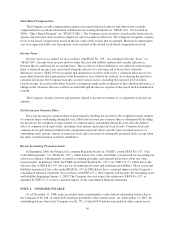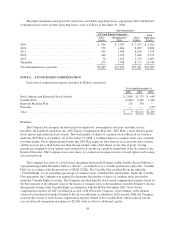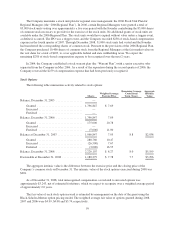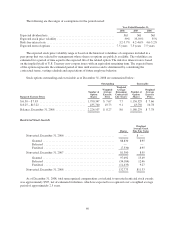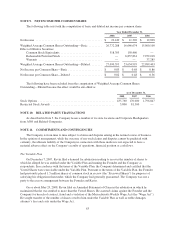Lumber Liquidators 2008 Annual Report Download - page 60
Download and view the complete annual report
Please find page 60 of the 2008 Lumber Liquidators annual report below. You can navigate through the pages in the report by either clicking on the pages listed below, or by using the keyword search tool below to find specific information within the annual report.Merchandise Inventories
The Company values merchandise inventories at the lower of cost or market. Merchandise cost is
determined using the average cost method. All of the hardwood flooring purchased from vendors is either
prefinished or unfinished, and in immediate saleable form. The Company adds the finish to, and boxes, various
species of unfinished product, to produce certain proprietary products, primarily Bellawood, at its finishing
facility. These finishing and boxing costs are included in the average unit cost of related merchandise inventory.
The Company maintains an inventory reserve for loss or obsolescence, based on historical results and current
sales trends. This reserve was $516 and $644 at December 31, 2008 and 2007, respectively.
Impairment of Long-Lived Assets
The Company evaluates potential impairment losses on long-lived assets used in operations when events
and circumstances indicate that the assets may be impaired, and the undiscounted cash flows estimated to be
generated by those assets are less than the carrying amounts of those assets. If impairment exists and the
undiscounted cash flows estimated to be generated by those assets are less than the carrying amount of those
assets, an impairment loss is recorded based on the difference between the carrying value and fair value of the
assets. No impairment charges were recognized in 2008, 2007 or 2006.
Goodwill and Other Indefinite-Lived Intangibles
Other assets include $1,050 of goodwill and $800 for an indefinite-lived intangible asset due to the 2008
purchase of the phone number 1-800-HARDWOOD and related internet domain names. The Company evaluates
these assets for impairment on an annual basis, or whenever events or changes in circumstance indicate that the
carrying value may be impaired. Based on the analysis performed, the Company has concluded that no
impairment in the value of these assets has occurred.
Self Insurance
Effective June 1, 2008, the Company self-insures for certain employee health benefit claims. Management
estimates a liability for aggregate losses below stop-loss coverage limits based on estimates of the ultimate costs
to be incurred to settle known claims and claims not reported as of the balance sheet date. The estimated liability
is not discounted and is based on a number of assumptions and factors including historical trends, actuarial
assumptions, and economic conditions. This liability could be affected if future occurrences and claims differ
from these assumptions and historical trends. As of December 31, 2008, an accrual of $281 related to estimated
claims was included in other current liabilities.
Recognition of Net Sales
The Company recognizes net sales for products purchased at the time the customer takes possession of the
merchandise. Service revenue, primarily freight charges for in-home delivery, is recognized when the service has
been rendered. The Company reports revenue net of sales and use taxes collected from customers and remitted to
governmental taxing authorities. Net sales are reduced by an allowance for anticipated sales returns based on
historical and current sales trends and experience. The sales returns allowance and related changes were not
significant for 2008, 2007 or 2006.
The Company generally requires customers to pay a deposit, equal to approximately 50% of the retail sales
value, when purchasing merchandise inventories not regularly carried in a given store location, or not currently in
stock. These deposits are included in customer deposits and store credits until the customer takes possession of
the merchandise.
54


